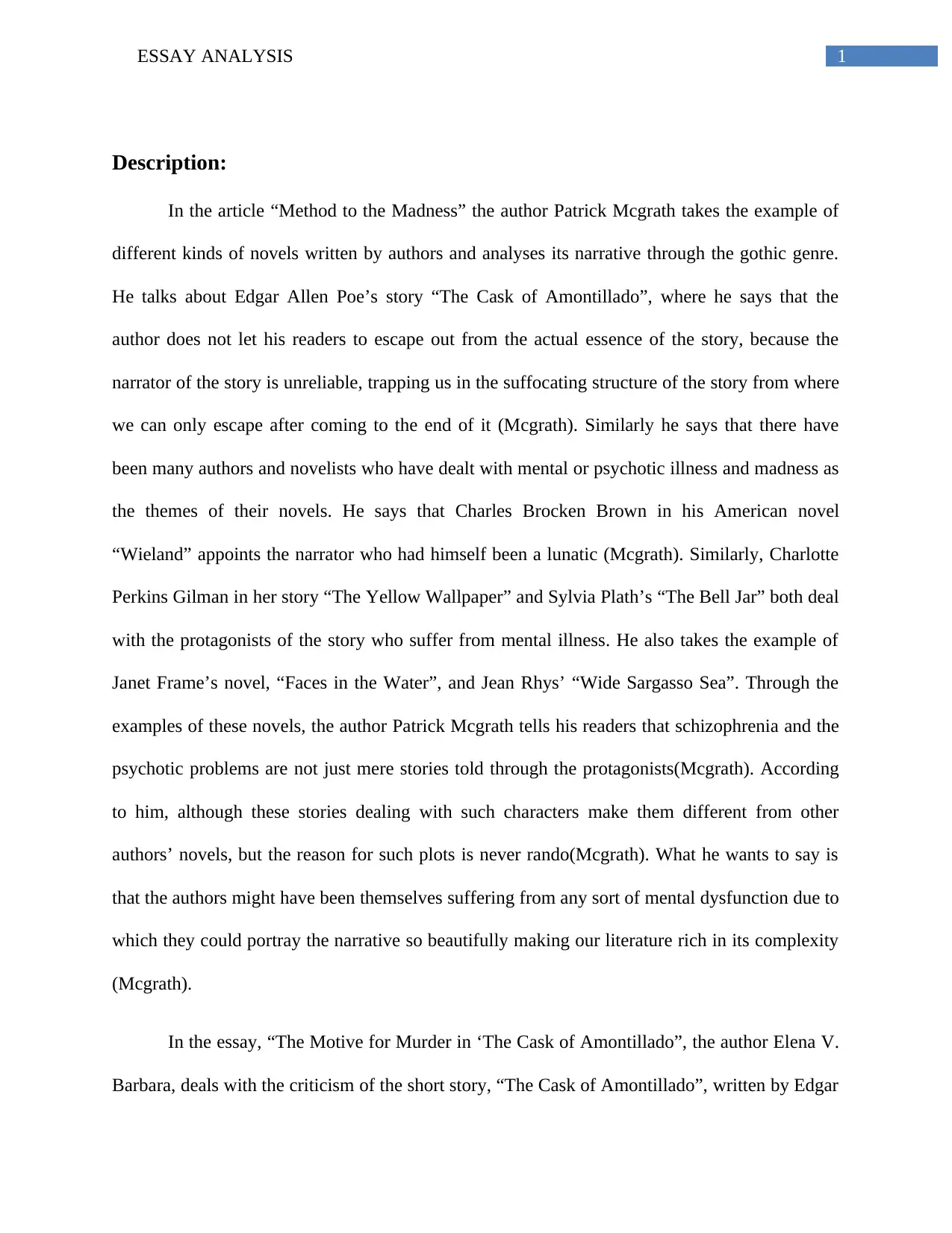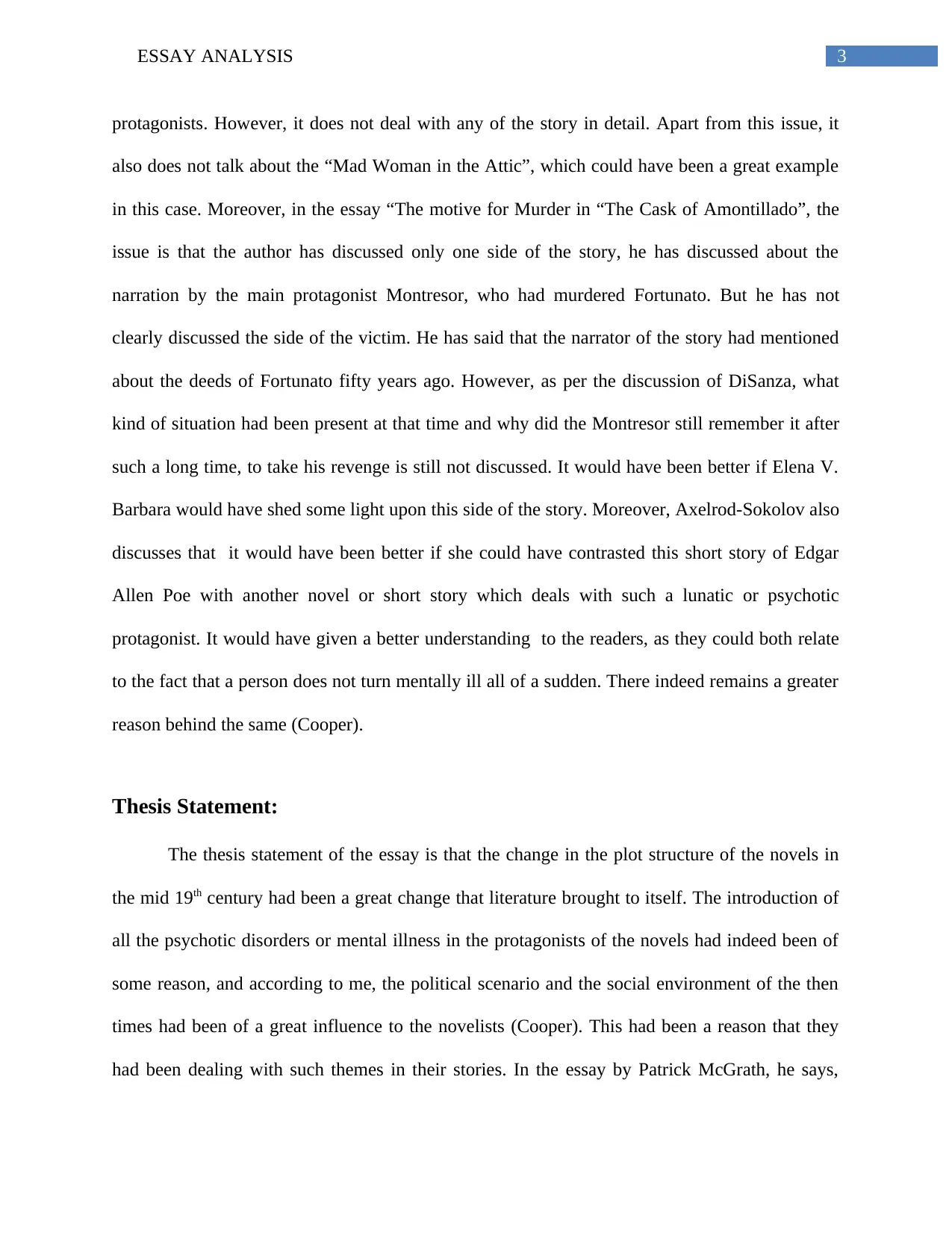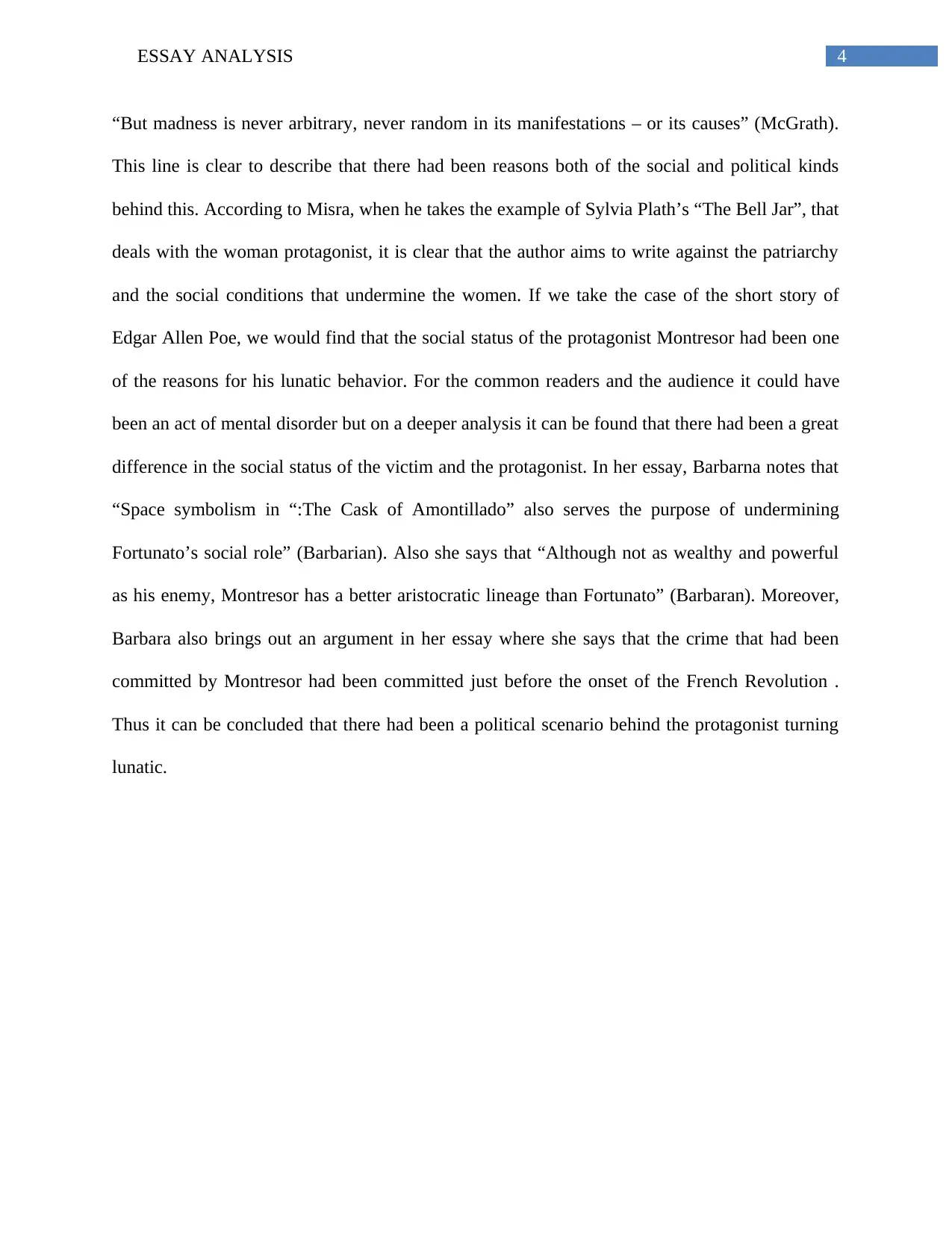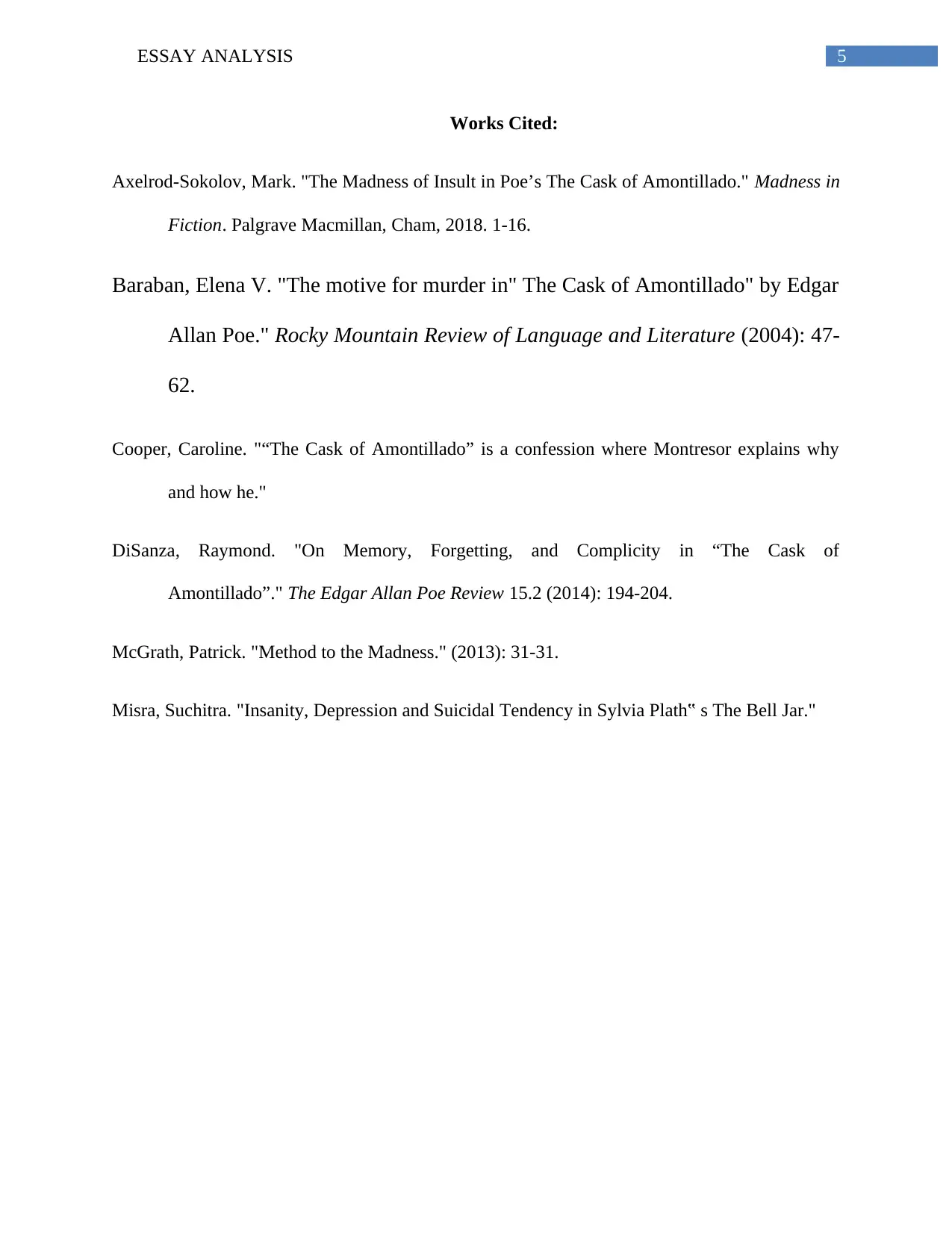Essay Analysis: Exploring Themes of Madness in Literature
VerifiedAdded on 2022/08/27
|6
|1603
|27
Essay
AI Summary
This essay analyzes two essays, "Method to the Madness" by Patrick McGrath and "The Motive for Murder in 'The Cask of Amontillado'" by Elena V. Barbara, focusing on the portrayal of mental illness and madness in literature, particularly within the gothic genre. The analysis examines how authors like Edgar Allan Poe, Charlotte Perkins Gilman, and Sylvia Plath use unreliable narrators and explore themes of schizophrenia and psychotic problems. The essay highlights the thesis that the changing plot structures of novels in the mid-19th century were influenced by the social and political environments of the time, leading to the inclusion of mental illness in protagonists. It points out that the author McGrath's line, "But madness is never arbitrary, never random in its manifestations – or its causes," clearly describes the social and political reasons behind the protagonists' actions. The essay also critiques the essays' limitations, such as a lack of detailed analysis of the protagonists' backgrounds and the omission of contrasting examples. It concludes by emphasizing the influence of social status and political scenarios on the portrayal of madness in literature, as seen in the case of Montresor's actions in Poe's short story.

Running head: ESSAY ANALYSIS
Essay Analysis
Name of the Student:
Name of the University:
Author Note:
Essay Analysis
Name of the Student:
Name of the University:
Author Note:
Paraphrase This Document
Need a fresh take? Get an instant paraphrase of this document with our AI Paraphraser

1ESSAY ANALYSIS
Description:
In the article “Method to the Madness” the author Patrick Mcgrath takes the example of
different kinds of novels written by authors and analyses its narrative through the gothic genre.
He talks about Edgar Allen Poe’s story “The Cask of Amontillado”, where he says that the
author does not let his readers to escape out from the actual essence of the story, because the
narrator of the story is unreliable, trapping us in the suffocating structure of the story from where
we can only escape after coming to the end of it (Mcgrath). Similarly he says that there have
been many authors and novelists who have dealt with mental or psychotic illness and madness as
the themes of their novels. He says that Charles Brocken Brown in his American novel
“Wieland” appoints the narrator who had himself been a lunatic (Mcgrath). Similarly, Charlotte
Perkins Gilman in her story “The Yellow Wallpaper” and Sylvia Plath’s “The Bell Jar” both deal
with the protagonists of the story who suffer from mental illness. He also takes the example of
Janet Frame’s novel, “Faces in the Water”, and Jean Rhys’ “Wide Sargasso Sea”. Through the
examples of these novels, the author Patrick Mcgrath tells his readers that schizophrenia and the
psychotic problems are not just mere stories told through the protagonists(Mcgrath). According
to him, although these stories dealing with such characters make them different from other
authors’ novels, but the reason for such plots is never rando(Mcgrath). What he wants to say is
that the authors might have been themselves suffering from any sort of mental dysfunction due to
which they could portray the narrative so beautifully making our literature rich in its complexity
(Mcgrath).
In the essay, “The Motive for Murder in ‘The Cask of Amontillado”, the author Elena V.
Barbara, deals with the criticism of the short story, “The Cask of Amontillado”, written by Edgar
Description:
In the article “Method to the Madness” the author Patrick Mcgrath takes the example of
different kinds of novels written by authors and analyses its narrative through the gothic genre.
He talks about Edgar Allen Poe’s story “The Cask of Amontillado”, where he says that the
author does not let his readers to escape out from the actual essence of the story, because the
narrator of the story is unreliable, trapping us in the suffocating structure of the story from where
we can only escape after coming to the end of it (Mcgrath). Similarly he says that there have
been many authors and novelists who have dealt with mental or psychotic illness and madness as
the themes of their novels. He says that Charles Brocken Brown in his American novel
“Wieland” appoints the narrator who had himself been a lunatic (Mcgrath). Similarly, Charlotte
Perkins Gilman in her story “The Yellow Wallpaper” and Sylvia Plath’s “The Bell Jar” both deal
with the protagonists of the story who suffer from mental illness. He also takes the example of
Janet Frame’s novel, “Faces in the Water”, and Jean Rhys’ “Wide Sargasso Sea”. Through the
examples of these novels, the author Patrick Mcgrath tells his readers that schizophrenia and the
psychotic problems are not just mere stories told through the protagonists(Mcgrath). According
to him, although these stories dealing with such characters make them different from other
authors’ novels, but the reason for such plots is never rando(Mcgrath). What he wants to say is
that the authors might have been themselves suffering from any sort of mental dysfunction due to
which they could portray the narrative so beautifully making our literature rich in its complexity
(Mcgrath).
In the essay, “The Motive for Murder in ‘The Cask of Amontillado”, the author Elena V.
Barbara, deals with the criticism of the short story, “The Cask of Amontillado”, written by Edgar

2ESSAY ANALYSIS
Allen Poe. HE says that the readers and critics analyses the story and concludes that Montresor
had been a lunatic since he had no motive in killing Fortunato (Barbaran). In this article he
argues about the hypothesis that there had been proper information embedded into the story itself
and there had been a definite reason behind the crime that Montresor had committed. The author
here analyses an criticizes the depth of the story and says that Montresor had been of an
aristocratic lineage, which is quite evident from his own narration, and due to the social status,
he did commit the crime, however according to him, Montresor did not basically commit a
crime, but he did an act of punishment or vengeance as is evident from the tone of narration of
Montresor (Barbaran). Barbara also concludes her essay by saying that the last words of
Montresor had been a clear proof that the motive of his murder had been vengeance because the
words that he had last spoken are generally said at the Requiem Mass (Barbaran). According to
the author, he had not been lunatic but had been seeking forgiveness as a repentant sinner. The
essay says that Montresor basically punished Fortunate due to the deed that he had done fifty
years ago (Barbaran).
Issue:
Although both of the essays are very well crafted and they deal with the issue with utmost
clarity, there are some issues that I have faced. The issue that I have with the first essay by is
that there had not been any clear evidence as in what had actually been the scenario behind the
mental illness of the protagonist. The author in his essay does not deal with the reasons behind
the same. According to Azelrod – Sokolov, he takes examples and lets the readers know that no
mental illness or psychotic deed happens without cause. This is indeed informative on one hand
and indeed lets the readers ponder upon their own insight as in what had gone wrong with the
Allen Poe. HE says that the readers and critics analyses the story and concludes that Montresor
had been a lunatic since he had no motive in killing Fortunato (Barbaran). In this article he
argues about the hypothesis that there had been proper information embedded into the story itself
and there had been a definite reason behind the crime that Montresor had committed. The author
here analyses an criticizes the depth of the story and says that Montresor had been of an
aristocratic lineage, which is quite evident from his own narration, and due to the social status,
he did commit the crime, however according to him, Montresor did not basically commit a
crime, but he did an act of punishment or vengeance as is evident from the tone of narration of
Montresor (Barbaran). Barbara also concludes her essay by saying that the last words of
Montresor had been a clear proof that the motive of his murder had been vengeance because the
words that he had last spoken are generally said at the Requiem Mass (Barbaran). According to
the author, he had not been lunatic but had been seeking forgiveness as a repentant sinner. The
essay says that Montresor basically punished Fortunate due to the deed that he had done fifty
years ago (Barbaran).
Issue:
Although both of the essays are very well crafted and they deal with the issue with utmost
clarity, there are some issues that I have faced. The issue that I have with the first essay by is
that there had not been any clear evidence as in what had actually been the scenario behind the
mental illness of the protagonist. The author in his essay does not deal with the reasons behind
the same. According to Azelrod – Sokolov, he takes examples and lets the readers know that no
mental illness or psychotic deed happens without cause. This is indeed informative on one hand
and indeed lets the readers ponder upon their own insight as in what had gone wrong with the
⊘ This is a preview!⊘
Do you want full access?
Subscribe today to unlock all pages.

Trusted by 1+ million students worldwide

3ESSAY ANALYSIS
protagonists. However, it does not deal with any of the story in detail. Apart from this issue, it
also does not talk about the “Mad Woman in the Attic”, which could have been a great example
in this case. Moreover, in the essay “The motive for Murder in “The Cask of Amontillado”, the
issue is that the author has discussed only one side of the story, he has discussed about the
narration by the main protagonist Montresor, who had murdered Fortunato. But he has not
clearly discussed the side of the victim. He has said that the narrator of the story had mentioned
about the deeds of Fortunato fifty years ago. However, as per the discussion of DiSanza, what
kind of situation had been present at that time and why did the Montresor still remember it after
such a long time, to take his revenge is still not discussed. It would have been better if Elena V.
Barbara would have shed some light upon this side of the story. Moreover, Axelrod-Sokolov also
discusses that it would have been better if she could have contrasted this short story of Edgar
Allen Poe with another novel or short story which deals with such a lunatic or psychotic
protagonist. It would have given a better understanding to the readers, as they could both relate
to the fact that a person does not turn mentally ill all of a sudden. There indeed remains a greater
reason behind the same (Cooper).
Thesis Statement:
The thesis statement of the essay is that the change in the plot structure of the novels in
the mid 19th century had been a great change that literature brought to itself. The introduction of
all the psychotic disorders or mental illness in the protagonists of the novels had indeed been of
some reason, and according to me, the political scenario and the social environment of the then
times had been of a great influence to the novelists (Cooper). This had been a reason that they
had been dealing with such themes in their stories. In the essay by Patrick McGrath, he says,
protagonists. However, it does not deal with any of the story in detail. Apart from this issue, it
also does not talk about the “Mad Woman in the Attic”, which could have been a great example
in this case. Moreover, in the essay “The motive for Murder in “The Cask of Amontillado”, the
issue is that the author has discussed only one side of the story, he has discussed about the
narration by the main protagonist Montresor, who had murdered Fortunato. But he has not
clearly discussed the side of the victim. He has said that the narrator of the story had mentioned
about the deeds of Fortunato fifty years ago. However, as per the discussion of DiSanza, what
kind of situation had been present at that time and why did the Montresor still remember it after
such a long time, to take his revenge is still not discussed. It would have been better if Elena V.
Barbara would have shed some light upon this side of the story. Moreover, Axelrod-Sokolov also
discusses that it would have been better if she could have contrasted this short story of Edgar
Allen Poe with another novel or short story which deals with such a lunatic or psychotic
protagonist. It would have given a better understanding to the readers, as they could both relate
to the fact that a person does not turn mentally ill all of a sudden. There indeed remains a greater
reason behind the same (Cooper).
Thesis Statement:
The thesis statement of the essay is that the change in the plot structure of the novels in
the mid 19th century had been a great change that literature brought to itself. The introduction of
all the psychotic disorders or mental illness in the protagonists of the novels had indeed been of
some reason, and according to me, the political scenario and the social environment of the then
times had been of a great influence to the novelists (Cooper). This had been a reason that they
had been dealing with such themes in their stories. In the essay by Patrick McGrath, he says,
Paraphrase This Document
Need a fresh take? Get an instant paraphrase of this document with our AI Paraphraser

4ESSAY ANALYSIS
“But madness is never arbitrary, never random in its manifestations – or its causes” (McGrath).
This line is clear to describe that there had been reasons both of the social and political kinds
behind this. According to Misra, when he takes the example of Sylvia Plath’s “The Bell Jar”, that
deals with the woman protagonist, it is clear that the author aims to write against the patriarchy
and the social conditions that undermine the women. If we take the case of the short story of
Edgar Allen Poe, we would find that the social status of the protagonist Montresor had been one
of the reasons for his lunatic behavior. For the common readers and the audience it could have
been an act of mental disorder but on a deeper analysis it can be found that there had been a great
difference in the social status of the victim and the protagonist. In her essay, Barbarna notes that
“Space symbolism in “:The Cask of Amontillado” also serves the purpose of undermining
Fortunato’s social role” (Barbarian). Also she says that “Although not as wealthy and powerful
as his enemy, Montresor has a better aristocratic lineage than Fortunato” (Barbaran). Moreover,
Barbara also brings out an argument in her essay where she says that the crime that had been
committed by Montresor had been committed just before the onset of the French Revolution .
Thus it can be concluded that there had been a political scenario behind the protagonist turning
lunatic.
“But madness is never arbitrary, never random in its manifestations – or its causes” (McGrath).
This line is clear to describe that there had been reasons both of the social and political kinds
behind this. According to Misra, when he takes the example of Sylvia Plath’s “The Bell Jar”, that
deals with the woman protagonist, it is clear that the author aims to write against the patriarchy
and the social conditions that undermine the women. If we take the case of the short story of
Edgar Allen Poe, we would find that the social status of the protagonist Montresor had been one
of the reasons for his lunatic behavior. For the common readers and the audience it could have
been an act of mental disorder but on a deeper analysis it can be found that there had been a great
difference in the social status of the victim and the protagonist. In her essay, Barbarna notes that
“Space symbolism in “:The Cask of Amontillado” also serves the purpose of undermining
Fortunato’s social role” (Barbarian). Also she says that “Although not as wealthy and powerful
as his enemy, Montresor has a better aristocratic lineage than Fortunato” (Barbaran). Moreover,
Barbara also brings out an argument in her essay where she says that the crime that had been
committed by Montresor had been committed just before the onset of the French Revolution .
Thus it can be concluded that there had been a political scenario behind the protagonist turning
lunatic.

5ESSAY ANALYSIS
Works Cited:
Axelrod-Sokolov, Mark. "The Madness of Insult in Poe’s The Cask of Amontillado." Madness in
Fiction. Palgrave Macmillan, Cham, 2018. 1-16.
Baraban, Elena V. "The motive for murder in" The Cask of Amontillado" by Edgar
Allan Poe." Rocky Mountain Review of Language and Literature (2004): 47-
62.
Cooper, Caroline. "“The Cask of Amontillado” is a confession where Montresor explains why
and how he."
DiSanza, Raymond. "On Memory, Forgetting, and Complicity in “The Cask of
Amontillado”." The Edgar Allan Poe Review 15.2 (2014): 194-204.
McGrath, Patrick. "Method to the Madness." (2013): 31-31.
Misra, Suchitra. "Insanity, Depression and Suicidal Tendency in Sylvia Plath‟ s The Bell Jar."
Works Cited:
Axelrod-Sokolov, Mark. "The Madness of Insult in Poe’s The Cask of Amontillado." Madness in
Fiction. Palgrave Macmillan, Cham, 2018. 1-16.
Baraban, Elena V. "The motive for murder in" The Cask of Amontillado" by Edgar
Allan Poe." Rocky Mountain Review of Language and Literature (2004): 47-
62.
Cooper, Caroline. "“The Cask of Amontillado” is a confession where Montresor explains why
and how he."
DiSanza, Raymond. "On Memory, Forgetting, and Complicity in “The Cask of
Amontillado”." The Edgar Allan Poe Review 15.2 (2014): 194-204.
McGrath, Patrick. "Method to the Madness." (2013): 31-31.
Misra, Suchitra. "Insanity, Depression and Suicidal Tendency in Sylvia Plath‟ s The Bell Jar."
⊘ This is a preview!⊘
Do you want full access?
Subscribe today to unlock all pages.

Trusted by 1+ million students worldwide
1 out of 6
Related Documents
Your All-in-One AI-Powered Toolkit for Academic Success.
+13062052269
info@desklib.com
Available 24*7 on WhatsApp / Email
![[object Object]](/_next/static/media/star-bottom.7253800d.svg)
Unlock your academic potential
Copyright © 2020–2025 A2Z Services. All Rights Reserved. Developed and managed by ZUCOL.





